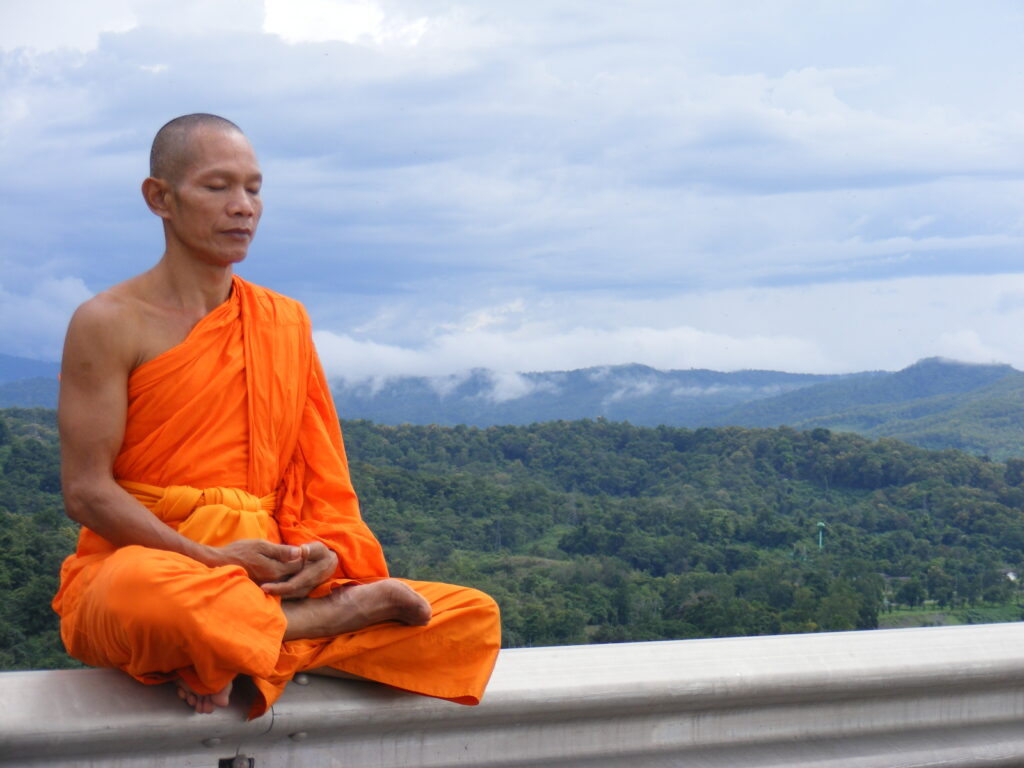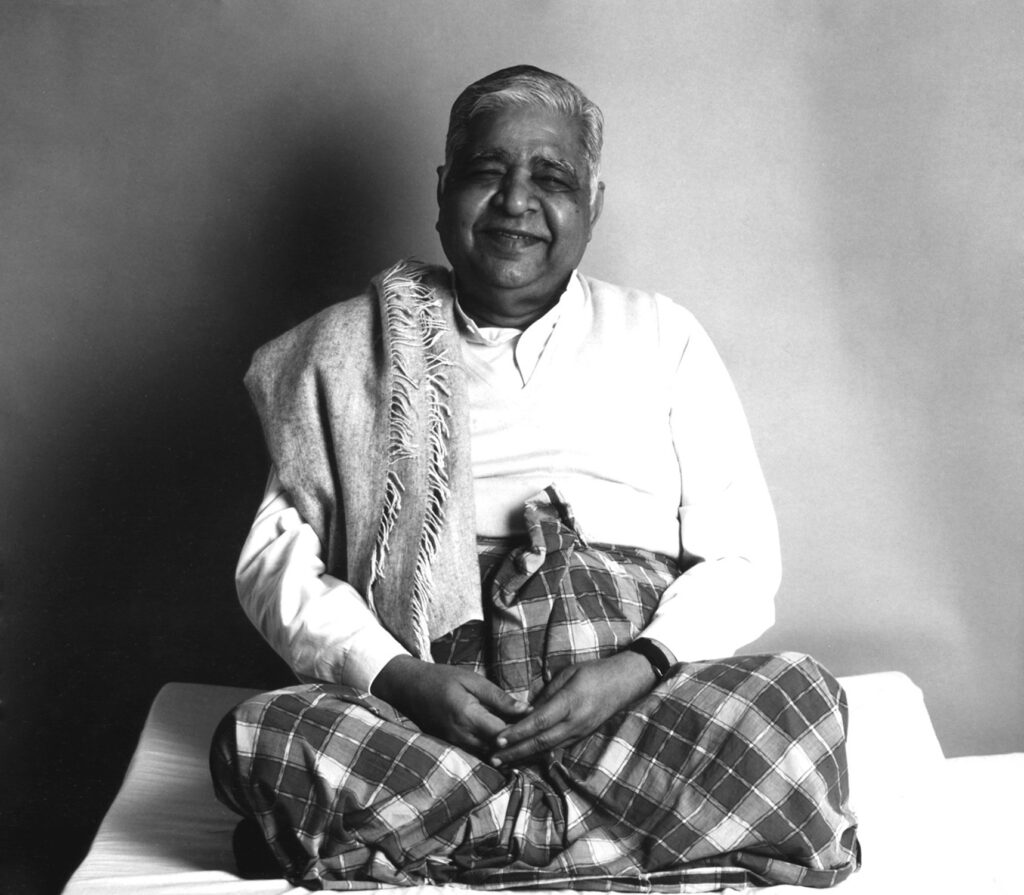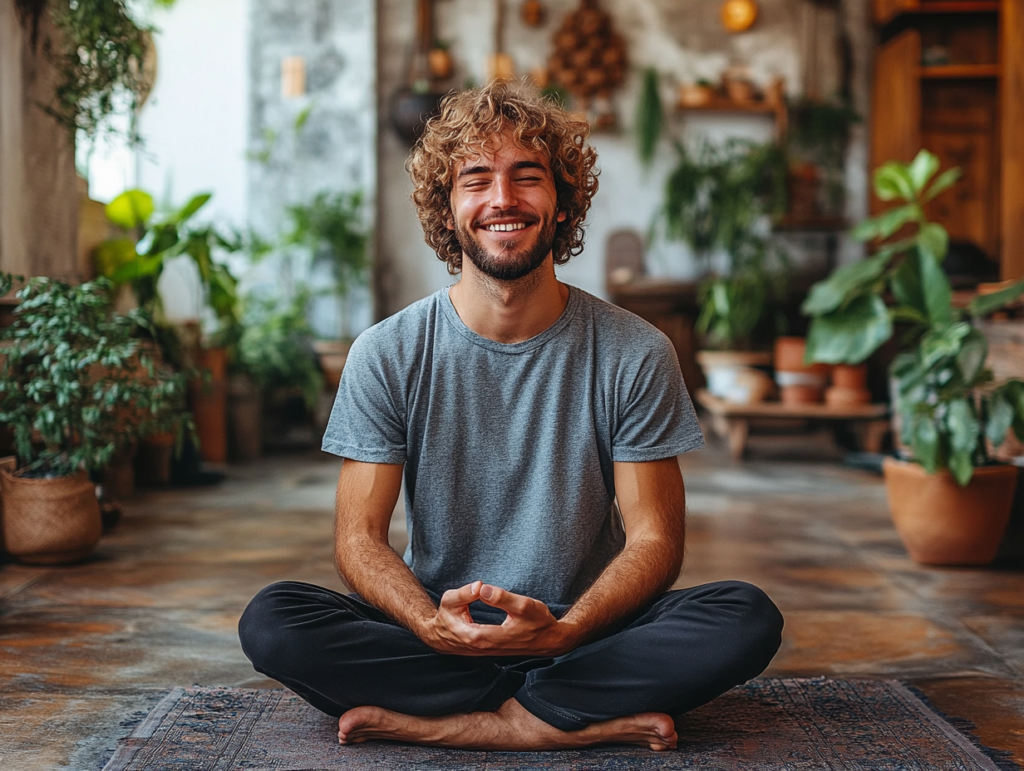Meditation has had a resurgence over the last few decades and science has jumped on board, with many studies hailing the health benefits of meditation (stress reduction, sleep quality, pain management, cardiovascular benefits, improved emotional wellbeing, etc). There are a plethora of different meditation techniques, but here we’ll be focusing on Vipassana meditation. Vipassana meditation is a type of meditation that has been growing in popularity over the last few decades, with hundreds of formal Vipassana meditation teachings sites build throughout the world funded entirely through donations of money and service.
Vipassana meditation has its origins 2500 years ago and was popularized by Siddhartha Gautama, more widely known as “Buddha”, (the founder of Buddhism). While Vipassana has its foundations in Buddhism, it is not specifically Buddhist, but rather universal and non-sectarian. Buddha literally translates to “enlightened one”, and it is through Vipassana meditation that the Buddha achieved enlightenment.
The primary goal of Vipassana meditation is to attain inner peace and self-awareness. It focuses on one’s breath and awareness of all sensations on the body. In this guide we’ll explore the intricacies of Vipassana meditation from its principles, five precepts, core concepts, how to practice Vipassana meditation, practical benefits and more (see table of contents below).
I took a 10-day Vipassana Meditation Course this past month, going into which I knew very little about Vipassana meditation. It was quite the challenge mentally and physically, and it was a new experience that taught me quite a lot.
Vipassana Meditation Ultimate Guide Contents
- What is Vipassana Meditation?
- The Three Pillars of Vipassana Meditation
- The Five Precepts of Vipassana Meditation
- Key Concepts in Vipassana Meditation
- The Practice of Vipassana Meditation
- What Happens During a 10-Day Vipassana Course?
- Practical Benefits of Vipassana Meditation
- How to Continue Vipassana Meditation After the Course
- FAQs About Vipassana Meditation
What is Vipassana Meditation?
Vipassana meditation is an ancient technique of self-transformation through the systematic observation of bodily sensations with equanimity. Rooted in the teachings of Gautama Buddha, Vipassana means “insight” or “clear seeing,” and it aims to develop deep self-awareness by observing the impermanent nature (anicca) of all experiences.
The practice involves focusing on the breath (Anapana) to cultivate concentration and then scanning the body to observe sensations without reacting with craving or aversion. Through consistent practice, Vipassana helps purify the mind, break deep-seated mental conditioning (sankhāras), and foster inner peace, resilience, and wisdom.
It is a secular practice accessible to people of all backgrounds, offering a practical path to greater clarity, balance, and liberation from suffering.

The Three Pillars of Vipassana Meditation
There are three main pillars that form the foundation of Vipassana meditation practice, these are:
- Sila – Moral conduct
- Samahdi – Concentration of Mind
- Panna – Wisdom of Insight
Sila
Sila, or moral conduct, refers to living according to a certain ethical framework. The idea is that Sila forms a foundation of good behaviour upon which wisdom and insight from meditation can be built. Sila includes leading a non-violent life, having self discipline, and integrity.
Sila is typically defined by the Five Precepts of Vipassana Meditation outlined below.
Samahdi
Focused awareness is a key aspect of Vipassana meditation, and Samahdi refers to just that: concentration of the mind. The technique taught in Vipassana courses is to focus on the breath, called Anapana. This intense focus on the breath is utilized as a tool to remain undistracted.
Paññā
The pillar of Wisdom of Insight – Paññā – recognizes impermanence, suffering, and the non-self through the experience of observing one’s body.
The Five Precepts of Vipassana Meditation
These Five Precepts of Vipassana Meditation are the guiding rules of Sila.
The Five Precepts
- To abstain from harming/killing any being
- To abstain from stealing
- To abstain from false speech
- To abstain from all intoxicants
- To abstain from sexual misconduct
In general these are good rules that most civilized societies and religions accept with few exceptions.
To abstain from harming/killing any being even extends to animals and insects. I presume this is a driving factor behind the vegetarian meals served during the 10-day Vipassana Courses world-wide. However, I’m confident that many Vipassana meditators are not vegetarian (I’ve met many who are not).
Abstaining from stealing is straightforward and well accepted.
Abstain from telling lies – generally a good rule of thumb, but this includes lies of omission, half truths, white lies, etc. Anything other than the straight truth.
Intoxicants can be quite broad, but is typically understood to be: alcohol, cannabis/marijuana, narcotics/opiates, recreational drugs (ecstasy, acid, etc), cocaine, shrooms, etc. However, this can also include things such as caffeine (dun dun dun).
Abstaining from sexual misconduct is an important and easy rule to follow. However, during a 10-day Vipassana course the rule is actually to Abstain from all sexual activity, which everyone has difficulty with. In real life practicing sexual abstinence is nigh impossible unless you’re a monk/nun. And it is not realistic for 99% of Vipassana meditators. Thankfully this rule only applies for 10-days during the course!

Key Concepts in Vipassana Meditation
- Noble Silence
- The Four Aspects of the Mind
- Misery and Suffering (Dukkha)
- Mental Conditioning (Sankhara)
- Impermanence (Anicca)
- Equanimity (Upekkha)
- Dhamma
Noble Silence
In Vipassana meditation, Noble Silence (or Sikkha) is a fundamental principle that helps practitioners cultivate mindfulness, equanimity, and spiritual growth. It’s a self-imposed silence that is observed during the meditation course to promote deep introspection, concentration, and insight.
Reasoning behind Noble Silence
The reasoning behind Noble Silence is rooted in the understanding that:
- Words can be a hindrance : Verbal communication can create distractions, attachments, and mental chatter. By minimizing external stimuli, practitioners can focus inwardly and develop greater awareness of their thoughts, emotions, and bodily sensations.
- Internal dialogue is a major obstacle : The constant stream of thoughts, worries, and doubts can prevent us from accessing the present moment. Noble Silence helps to quiet the internal dialogue, allowing for a deeper exploration of one’s mental and emotional landscape.
- Mindfulness requires attention to inner experiences : In Vipassana meditation, practitioners focus on observing their own experiences, rather than engaging with external stimuli. Noble Silence facilitates this process by removing the distraction of external communication.
The Four Aspects of the Mind
In daily life, individuals experience the constant interplay of the “Four Minds,” which represent different aspects of how we process and react to the world around us. These mental processes occur automatically, often without conscious awareness, leading to habitual patterns of craving and aversion. Vipassana meditation aims to bring awareness to these processes, allowing individuals to observe and intercept unconscious reactions before they manifest as negative emotional responses.
By understanding the Four Minds and their roles, one can develop greater self-awareness and emotional regulation, leading to a more balanced and intentional way of living.
The Four Minds are:
- Sensing/Perceiving (Viññāṇa)
- Cognizing (Manasikāra)
- Recognizing (Saññā)
- Reacting (Sankhāra)
1. Sensing/Perceiving (Viññāṇa)
Sensing, also known as perception or consciousness, is the initial stage in which the mind receives raw input from the five senses:
- Sight (vision)
- Sound (hearing)
- Smell (olfaction)
- Taste (gustation)
- Touch (somatosensation)
At this level, the mind is purely registering external stimuli without interpretation or judgment. For example, when you hear a sound, the ears detect the vibration, and the brain registers it without yet assigning meaning.
In the context of Vipassana meditation, practitioners learn to observe sensory experiences as they arise, recognizing them as impermanent and neutral rather than reacting to them impulsively.
2. Cognizing (Manasikāra)
Once a stimulus has been sensed, the mind moves to the stage of cognizing, where attention is directed to the sensory input, and initial mental processing begins.
At this stage, the mind determines whether the sensory input is relevant or important, focusing on certain stimuli while ignoring others. For instance, in a crowded room, your mind might focus on the voice of a friend while tuning out background noise.
Vipassana meditation cultivates awareness of this process by training the practitioner to notice how attention is directed and to remain present without becoming lost in mental distractions. This awareness helps prevent unnecessary mental clutter and enhances focus.
3. Recognizing (Saññā)
Recognition involves labeling and categorizing sensory input based on past experiences, memories, and learned associations.
For example, after hearing a particular sound, the mind identifies it as a bird chirping or a car horn based on previous encounters. Recognition allows for quick decision-making and helps us navigate the world efficiently, but it can also lead to unconscious biases and conditioned reactions.
In meditation, practitioners observe the tendency of the mind to label experiences and form judgments. By becoming aware of this process, they can break free from automatic reactions and cultivate a fresh, unbiased perspective.
4. Reacting (Sankhāra)
The final stage in the process is reaction, where the mind forms an emotional or physical response based on the recognized stimulus.
Reactions can manifest as cravings (if the experience is pleasant) or aversions (if it is unpleasant). Over time, repeated reactions form deep-rooted mental habits that shape behavior and influence overall well-being.
For instance, hearing a critical remark might trigger feelings of anger or defensiveness, leading to negative emotional patterns. Vipassana meditation teaches individuals to observe their reactions objectively, creating a gap between stimulus and response. This allows for greater control over emotions and the development of equanimity.
Vipassana’s Role in Observing the Four Minds
Vipassana meditation provides a structured approach to observing the Four Minds in action. Through mindful awareness, individuals can:
- Recognize the initial sensory perceptions without becoming attached.
- Observe how their attention shifts and influences perception.
- Notice the habitual labeling process and question its validity.
- Intercept unconscious reactions, responding with awareness and balance.
By practicing non-reactivity and understanding the impermanent nature of sensations and thoughts, individuals gradually free themselves from the cycle of craving and aversion, leading to greater mental clarity and emotional resilience.

Misery and Suffering (Dukkha)
In the context of Vipassana meditation, Misery refers to the inherent dissatisfaction and discomfort that arises from our experiences. This concept is closely related to suffering (Dukkha), but not exactly the same.
What is Misery?
Misery is a fundamental aspect of human experience, encompassing physical, emotional, and mental distress. The Buddhist belief is that all misery stems from either craving or aversion. You experience misery either when:
- You do not obtain what you crave for, or
- You do get what you have an aversion for
Misery can take many forms, including:
- Physical pain or discomfort
- Emotional distress, such as anxiety, depression, or anger
- Mental frustration or confusion
- Sense of inadequacy or low self-esteem
The Role of Craving (Tanha) in Misery
Craving is a primary cause of misery, as our tendency to cling to pleasure, comfort, and security can lead to attachment and suffering. It manifests in many forms, including:
- Longing for sensory pleasures (e.g., delicious food, pleasant sounds, comfortable environments)
- Seeking emotional validation, love, or recognition
- Attachment to success, relationships, or material possessions
- Yearning for past pleasurable experiences or anticipating future ones
The Role of Aversion (Dosa) in Misery
Aversion is another primary cause of misery, as our resistance to pain, discomfort, or unpleasantness can lead to suffering. It often presents itself as:
- Avoidance of pain, discomfort, or difficult emotions
- Resistance to criticism, failure, or loss
- Frustration with life’s uncertainties and uncontrollable events
- Fear of negative thoughts or painful memories
Suffering/Dukkha?
While misery and suffering (Dukkha) are related concepts, they are not exactly the same.
- Dukkha refers to the broader concept of existential suffering—the inherent unsatisfactoriness and impermanence of life. It encompasses physical, mental, and existential struggles experienced universally by all beings.
- Misery, on the other hand, can be seen as a more personal, immediate experience resulting from one’s conditioned mental habits of craving and aversion.
Mental Conditioning (Sankhara)
Sankhāra (Mental Conditioning), in the context of Vipassana meditation, refers to the deep-rooted mental conditioning and habitual patterns that shape our thoughts, emotions, and behaviors. These mental formations are accumulated over a lifetime—often unconsciously—through repeated cycles of craving (tanha) and aversion (patigha) in response to life’s experiences. Sankhāras influence how we perceive and react to the world, contributing to the cycle of misery and suffering (dukkha).
How Sankhāras Are Formed
Sankhāras are created whenever we react to experiences with attachment or resistance. Each reaction leaves an imprint on the subconscious mind, reinforcing habitual patterns over time. For example:
- A positive experience (e.g., receiving praise) may lead to a craving for more validation in the future.
- A negative experience (e.g., facing rejection) may result in aversion and avoidance in similar situations later.
These accumulated mental impressions create a conditioned response system that dictates how we respond to new situations, often without conscious awareness. Over time, sankhāras become deeply ingrained, leading to automatic reactions that perpetuate suffering.
The Role of Sankhāra in Misery
Sankhāras are responsible for the recurring patterns of emotional and mental distress that individuals experience. They reinforce negative tendencies such as:
- Anxiety and fear from past traumas
- Attachments to material or emotional comforts
- Reactive anger in challenging situations
- Cycles of guilt, regret, and self-criticism
Because sankhāras are built through repetition, they create strong mental conditioning that can be difficult to break without conscious effort and practice.
Impermanence (Anicca)
Impermanence, or Anicca, is a core principle in Vipassana meditation that refers to the ever-changing, transient nature of all phenomena—whether physical, mental, or emotional. According to this teaching, nothing in life remains fixed; everything arises and passes away continuously. Recognizing and experiencing this truth firsthand through meditation is essential to overcoming suffering and achieving liberation.
Understanding the Nature of Impermanence
Impermanence applies to every aspect of existence, including:
- Physical Sensations: Every bodily sensation—whether pleasurable, painful, or neutral—constantly changes. A feeling of comfort may quickly turn into discomfort, and vice versa.
- Emotions and Thoughts: Feelings of joy, sadness, anger, or excitement are all fleeting and subject to change.
- Life Circumstances: Relationships, career situations, health, and material possessions all evolve over time, often beyond our control.
Despite this reality, people tend to cling to the illusion of permanence, leading to suffering when things inevitably change. Vipassana helps dismantle this illusion by offering direct experience of impermanence at the sensory level.
Experiencing Impermanence Through Vipassana
During Vipassana meditation, practitioners are trained to observe bodily sensations with mindfulness and equanimity. Through consistent practice, they begin to notice that:
- Sensations arise and pass away on their own, without any control.
- Even the most intense pain or pleasure is not constant; it fluctuates and eventually disappears.
- Observing this impermanence without attachment or aversion helps to weaken deep-rooted mental conditioning (sankhāras).
By directly experiencing Anicca, meditators develop the wisdom to accept life’s changes without resistance, leading to greater peace and resilience.
Equanimity (Upekkha)
Equanimity, or Upekkhā, is the ability to remain balanced and composed in the face of life’s ever-changing experiences. It is a state of inner stability that allows one to observe both pleasant and unpleasant sensations, thoughts, and emotions without reacting with craving or aversion. In the practice of Vipassana meditation, developing equanimity is a crucial step toward breaking free from the cycles of suffering and achieving true inner peace.
Understanding Equanimity in the Context of Vipassana
Equanimity is the quality of observing experiences objectively, without getting attached to positive experiences or resisting negative ones. It is not indifference or suppression of emotions, but rather a deep understanding that:
- Everything is impermanent (Anicca): Both pleasurable and painful experiences arise and pass away.
- Reactivity leads to suffering (Dukkha): Craving pleasure and avoiding discomfort only perpetuates misery.
- Non-attachment brings freedom: By maintaining balance, one can navigate life with greater wisdom and clarity.
Vipassana meditation cultivates equanimity by training the mind to observe sensations—whether pain, pleasure, or neutrality—without reaction, thereby reducing habitual patterns of attachment and aversion.
Dhamma in Vipassana Meditation: Understanding the Universal Law of Nature
Dhamma, often translated as “the law of nature” or “universal truth,” is a central concept in Vipassana meditation. It refers to the fundamental principles that govern existence, such as impermanence (anicca), suffering (dukkha), and non-self (anatta). Practicing Vipassana is a means of aligning oneself with Dhamma—experiencing reality as it is, without illusion or distortion.
Dhamma is not limited to religious belief; rather, it is an experiential understanding of how life operates at a deeper level, beyond cultural or doctrinal boundaries. It represents the path to liberation through self-observation, wisdom, and right action.
The Meaning of Dhamma in Vipassana Practice
In the context of Vipassana meditation, Dhamma encompasses:
- The Universal Law of Impermanence:
- Everything in life arises and passes away; nothing is permanent.
- Understanding this reality helps dissolve attachment and aversion, leading to inner peace.
- The Path to Liberation:
- Dhamma is the practical way to free oneself from suffering by cultivating morality (sila), concentration (samadhi), and wisdom (panna).
- Vipassana provides the tools to walk this path through self-exploration.
- Living in Harmony with Nature:
- Practicing Dhamma means living ethically, truthfully, and with mindfulness in every aspect of life.
- It encourages compassion, self-discipline, and a non-reactive approach to life’s challenges.

The Practice of Vipassana Meditation
The practice of Vipassana meditation is a systematic process aimed at developing deep self-awareness and insight into the true nature of reality. It consists of several techniques that help practitioners cultivate focus, observe bodily sensations, and develop equanimity. The journey begins with Anapana (breath awareness) and progresses to body scanning, with special emphasis on awareness of pain and comfort, the cultivation of determination (Adhiṭṭhāna), and other practical elements essential to mastering the technique.
Anapana: Developing Concentration Through Breath Awareness
The first step in Vipassana meditation is the practice of Anapana, which involves observing the natural breath as it flows in and out of the nostrils.
- Purpose: To sharpen the mind and develop sustained concentration (samadhi), preparing it for deeper introspection.
- Technique: Practitioners are instructed to focus on the small area between the nostrils and the upper lip, observing the breath without controlling it.
- Benefits: This practice helps calm the mind, increase focus, and become more aware of subtle bodily sensations.
By practicing Anapana, meditators learn to cultivate mindfulness and mental discipline, which forms the foundation for the deeper practice of Vipassana.
Body Scanning: Observing Sensations with Equanimity
Once concentration is sufficiently developed through Anapana, practitioners begin the core practice of Vipassana: body scanning.
- Purpose: To cultivate insight (panna) by observing bodily sensations with equanimity, realizing their impermanent nature (anicca).
- Technique: Meditators systematically scan the body from head to toe, observing sensations such as tingling, pressure, itching, or pain without reacting.
- Key Principle: All sensations, whether pleasant or unpleasant, arise and pass away. Observing them without craving or aversion helps dissolve deep-rooted mental conditioning (sankhāras).
Through regular practice, body scanning allows practitioners to experience reality as it is and develop deep insight into the impermanence of all experiences.
Adhiṭṭhāna and Observing Pain and Comfort
Adhiṭṭhāna, meaning “strong determination,” is a critical aspect of Vipassana meditation that involves cultivating the ability to sit motionless for the duration of a meditation session while maintaining awareness and equanimity toward bodily sensations—whether painful, pleasant, or neutral. This practice builds both mental and physical endurance, helping practitioners break free from habitual reactions of craving and aversion.
Developing Equanimity Through Adhiṭṭhāna
During extended meditation sittings, practitioners inevitably encounter:
- Physical Discomfort (Pain): Aches, tension, numbness, or restlessness arise naturally as the body remains still for long periods. The practice encourages observing these sensations with calm awareness, rather than reacting with frustration or a desire to shift positions.
- Pleasant Sensations (Comfort): When experiencing comfort or lightness in the body, the mind often wants to cling to these sensations. Vipassana teaches practitioners to observe them without attachment, recognizing their transient nature.
By staying still and observing these experiences without reaction, meditators develop:
- Patience and Endurance: Learning to accept discomfort without resistance.
- Mental Strength: Training the mind to remain steady and composed under pressure.
- Insight into Impermanence (Anicca): Directly experiencing how sensations arise and pass away, deepening the understanding that nothing is permanent.
The Practical Role of Adhiṭṭhāna in Daily Life
Beyond formal meditation sessions, Vipassana practice encourages practitioners to cultivate continuous awareness and equanimity throughout daily life.
- Mindfulness in Routine Activities: Observing bodily sensations while walking, eating, or engaging in conversations.
- Self-Observation in Challenging Moments: Recognizing emotional triggers and responding with wisdom rather than impulse.
- Integration into Daily Life: Applying the principles of non-reaction and impermanence to relationships, work, and personal goals.
By maintaining awareness outside of meditation, practitioners deepen their practice and make it an integral part of their lives.
Metta Bhavana: Cultivating Loving-Kindness
Metta Bhavana, or the practice of loving-kindness meditation, is an essential complement to Vipassana meditation. Introduced toward the end of a 10-day Vipassana course, Metta Bhavana helps to balance the deep introspection of Vipassana with the cultivation of goodwill and compassion toward oneself and others. While Vipassana focuses on self-purification through objective observation, Metta Bhavana generates positive emotions that support inner peace and harmonious relationships.
The Purpose of Metta Bhavana
The goal of Metta Bhavana is to:
- Develop unconditional love and compassion for all beings.
- Reduce negative emotions such as anger, resentment, and fear.
- Enhance feelings of connection and empathy in daily interactions.
- Promote inner harmony and contribute to a peaceful mind.
By cultivating loving-kindness, meditators learn to extend the sense of equanimity they develop through Vipassana to their relationships and interactions with the world around them.
The Technique of Metta Bhavana
After completing a Vipassana meditation session, practitioners are encouraged to:
- Generate Positive Intentions: Mentally cultivate thoughts of goodwill, such as:
- “May I be happy, may I be peaceful, may I be free from suffering.”
- Gradually extend these thoughts toward others, including loved ones, acquaintances, and even those with whom one has difficulties.
- Radiate Loving-Kindness: Allow the feelings of warmth and kindness to expand outward, visualizing them encompassing all beings, regardless of differences.
- Maintain Equanimity: While sending out positive wishes, it is important to remain equanimous, understanding that one cannot control external outcomes but can always nurture goodwill internally.
Benefits of Metta Bhavana
Regular practice of Metta Bhavana offers numerous benefits, including:
- Emotional Healing: Helps release deep-seated negative emotions and grudges.
- Improved Relationships: Fosters understanding, patience, and compassion in personal and professional life.
- Enhanced Self-Acceptance: Encourages a gentle and compassionate attitude toward oneself, counteracting self-criticism and doubt.
- Increased Positivity: Cultivating loving-kindness can lead to a more optimistic and content state of mind.
Integrating Metta Bhavana into Daily Life
The practice of loving-kindness can be applied beyond formal meditation sessions by:
- Consciously extending kind thoughts toward others during daily interactions.
- Practicing patience and understanding in difficult situations.
- Expressing gratitude and appreciation for others without expecting anything in return.
- Using Metta Bhavana as a tool to counteract negative emotions when they arise.

S. N. Goenka (Satya Narayan Goenka) was a renowned teacher of Vipassana meditation, a non-sectarian technique of self-purification through mindfulness and insight. Born in 1924 in Burma (now Myanmar) to an Indian business family, he learned Vipassana meditation from Sayagyi U Ba Khin, a prominent Burmese meditation teacher and government official.
Goenka dedicated his life to spreading Vipassana meditation around the world after moving to India in 1969. He taught it as a universal, non-religious practice beneficial to people of all backgrounds. His approach emphasized observing bodily sensations to develop equanimity and insight into the nature of suffering.
What Happens During a 10-Day Vipassana Course?
A 10-day Vipassana course is an immersive meditation retreat designed to introduce participants to the core principles and techniques of Vipassana meditation in a structured and supportive environment. The course follows a rigorous schedule focused on cultivating self-discipline, deep concentration, and insight into the nature of reality. Participants commit to following strict guidelines and practices that help them experience the technique’s full benefits.
1. Daily Schedule and Routine
The course follows a highly structured schedule with nearly 10 hours of meditation per day, interspersed with breaks for meals and rest. A typical daily schedule includes:
- 4:00 AM: Wake-up bell
- 4:30 – 6:30 AM: Meditation session
- 6:30 – 8:00 AM: Breakfast and rest
- 8:00 – 11:00 AM: Meditation session with guidance
- 11:00 – 1:00 PM: Lunch and rest
- 1:00 – 5:00 PM: Meditation session
- 5:00 – 6:00 PM: Tea break (no dinner, only tea and fruit for new students)
- 6:00 – 7:00 PM: Group meditation session
- 7:00 – 8:30 PM: Evening discourse by S.N. Goenka (video or audio)
- 8:30 – 9:00 PM: Final meditation and reflection
- 9:00 PM: Lights out
This schedule is designed to help participants maintain focus and discipline while gradually deepening their meditation practice.
2. Noble Silence (Ariya Mauna)
From the beginning of the course, participants observe Noble Silence, meaning they must refrain from:
- Speaking to others (except for course management or teachers if necessary).
- Making eye contact or gestures.
- Reading, writing, or using electronic devices.
The purpose of Noble Silence is to minimize distractions, allowing participants to focus entirely on their inner experiences and progress in their meditation practice.
3. The Progressive Teaching of Vipassana Meditation
The course is carefully structured to introduce the Vipassana technique step by step:
- Days 1-3: Anapana Meditation (Breath Awareness)
- The first three days are dedicated to focusing the mind through Anapana, observing the natural breath at the area between the nostrils and upper lip.
- This helps sharpen concentration (samadhi) and prepare the mind for deeper observation.
- Days 4-9: Vipassana Meditation (Body Scanning Technique)
- On the fourth day, the core Vipassana technique is introduced—systematically scanning the body and observing sensations without reacting.
- Practitioners learn to maintain equanimity (upekkha) in the face of both pleasant and unpleasant sensations.
- Sitting with determination (Adhiṭṭhāna) is introduced to strengthen mental discipline.
- Day 10: Metta Bhavana (Loving-Kindness Meditation)
- On the final full day, participants practice Metta Bhavana, generating feelings of goodwill and compassion for themselves and others.
- Noble Silence is lifted, allowing participants to gradually reintegrate into normal communication.
4. Ethical Code and the Five Precepts
Throughout the course, participants commit to observing the Five Precepts, which are fundamental ethical guidelines to support mental purification:
- Abstaining from killing any being.
- Abstaining from stealing.
- Abstaining from false speech.
- Abstaining from sexual activity.
- Abstaining from intoxicants.
Following these precepts creates an environment conducive to inner work and self-discipline.
5. Challenges Faced During the Course
Participants often experience various challenges during the retreat, such as:
- Physical discomfort: Sitting for long hours can lead to stiffness and aches.
- Mental restlessness: The mind may resist stillness, leading to impatience or frustration.
- Emotional upheavals: Suppressed emotions may surface as the mind becomes more sensitive.
Overcoming these challenges with patience and equanimity is an essential part of the learning process.
6. Meals and Accommodation
The course provides simple vegetarian meals designed to support the practice by offering light, nutritious food without overstimulating the body. Meals typically include:
- Breakfast: Porridge, fruit, toast, tea.
- Lunch: Rice, vegetables, salad, dal (lentils).
- Evening tea break: Tea with fruit (only for new students; returning students have tea only).
Accommodations are basic but comfortable, typically in shared rooms or dormitories, offering a distraction-free environment for practice.
7. Teacher Guidance and Support
Though participants observe silence, they receive ongoing guidance from:
- Daily video discourses by S.N. Goenka, which provide insights into the philosophy and practical aspects of Vipassana.
- Personal interviews with teachers, allowing students to ask questions or seek clarification when needed.
- Course management support, available for logistical concerns.
8. The Final Day: Transitioning Back to Daily Life
On Day 10, Noble Silence is lifted, and participants can speak with fellow meditators. This transition helps ease them back into regular communication while maintaining mindfulness.
The final discourse provides practical guidance on how to:
- Continue practicing Vipassana at home.
- Apply mindfulness and equanimity in daily life.
- Maintain a regular meditation schedule to deepen the practice.
Practical Benefits of Vipassana Meditation
Vipassana meditation offers a wide range of practical benefits that extend beyond the meditation cushion and into everyday life. By cultivating self-awareness, equanimity, and insight into the nature of reality, practitioners experience profound improvements in their mental, emotional, and even physical well-being. The practice provides practical tools to navigate life’s challenges with greater clarity, resilience, and inner peace.
Because these contain some claims that are medical/psychological in nature I have included this article that has been medically reviewed as a source as well as another article here.


1. Emotional Resilience and Stress Reduction
One of the most immediate benefits of Vipassana is its ability to reduce stress and promote emotional resilience. By observing sensations without reacting, practitioners learn to:
- Manage stress more effectively and respond to challenges with a calm, balanced mind.
- Reduce anxiety by recognizing the impermanence of negative thoughts and emotions.
- Cultivate a sense of inner peace, regardless of external circumstances.
Over time, this leads to greater emotional stability and the ability to handle life’s ups and downs with composure.
2. Improved Focus and Mental Clarity
Vipassana enhances concentration and mental sharpness by training the mind to remain present and attentive. Benefits include:
- Increased focus and productivity in daily tasks.
- Enhanced decision-making by reducing impulsive reactions and promoting rational thinking.
- A clearer understanding of thoughts and emotions, leading to better self-awareness.
By practicing mindfulness through Vipassana, individuals become more efficient and effective in their personal and professional lives.
3. Breaking Unhealthy Patterns and Habits
Through consistent practice, Vipassana helps individuals break free from deep-seated mental conditioning (sankhāras) that fuel negative habits such as:
- Overeating or emotional eating.
- Reacting impulsively in relationships or conflicts.
- Addictive behaviors driven by craving and aversion.
By recognizing these patterns as impermanent and observing them with equanimity, practitioners gain the power to change destructive behaviors and cultivate healthier habits.
4. Greater Patience and Tolerance
Vipassana fosters patience by teaching individuals to sit with discomfort and observe sensations without reacting. This translates into:
- Better relationships through improved listening and understanding.
- Reduced frustration in challenging situations, whether at work or in personal life.
- The ability to remain composed and patient during difficult conversations or conflicts.
5. Enhanced Physical Well-Being
Although Vipassana is primarily a mental practice, it can have significant physical benefits, such as:
- Lowering blood pressure and improving heart health through stress reduction.
- Improved sleep quality by calming the mind and reducing restlessness.
- Enhanced pain management by observing physical sensations without resistance, leading to reduced perceived pain.
Practicing Vipassana allows individuals to develop a deeper connection between mind and body, fostering overall well-being.
6. Developing Compassion and Interpersonal Skills
Vipassana helps cultivate metta bhavana, or loving-kindness, toward oneself and others. By practicing non-judgmental awareness, individuals become more compassionate, leading to:
- Improved relationships based on empathy and understanding.
- Greater kindness and patience in social interactions.
- The ability to respond to others’ emotions with wisdom rather than impulsivity.
7. Long-Term Personal Growth and Self-Discovery
Ultimately, Vipassana offers a path to profound personal transformation by providing insights into the nature of the mind and self. Over time, practitioners experience:
- A deeper understanding of their motivations and behaviors.
- A greater sense of purpose and fulfillment.
- The ability to live with greater authenticity and integrity.
How to Continue Vipassana Meditation After the Course
Completing a Vipassana meditation course is just the beginning of a lifelong journey toward self-awareness and inner peace. To maintain and deepen the insights gained during the course, it is essential to establish a consistent practice and integrate Vipassana principles into daily life. Continuing the practice helps prevent old mental habits from resurfacing and supports ongoing personal transformation.




1. Establishing a Daily Meditation Routine
Consistency is key to reaping the full benefits of Vipassana. It is recommended to:
- Meditate twice a day: Practitioners are encouraged to practice Vipassana for one hour in the morning and one hour in the evening.
- Create a dedicated meditation space: A quiet, comfortable, and distraction-free environment helps sustain focus and commitment.
- Start small and build gradually: If two hours daily feels overwhelming, begin with shorter sessions and gradually increase the duration.
Building meditation into your daily routine makes it a sustainable and enriching practice.
2. Integrating Vipassana into Daily Life
Beyond formal sitting practice, Vipassana encourages mindfulness throughout the day. Key ways to integrate it into everyday activities include:
- Mindful awareness: Observe bodily sensations, thoughts, and emotions during routine tasks such as walking, eating, or working.
- Responding rather than reacting: Apply equanimity in daily interactions by pausing before reacting impulsively.
- Living with ethical conduct (Sila): Continue following the five precepts to support mental clarity and emotional balance.
By maintaining awareness in daily activities, practitioners can experience the benefits of Vipassana in real-world situations.
3. Attending Group Sittings
Participating in group sittings with other Vipassana practitioners can provide motivation, guidance, and a sense of community. Benefits of group sittings include:
- Reinforcement of practice through collective energy and discipline.
- Opportunities to clarify doubts and receive support from experienced practitioners.
- Staying connected to the Vipassana community for ongoing encouragement.
Many Vipassana centers and local groups offer regular sittings, both in-person and online.
4. Periodic Retreats for Deeper Practice
To deepen one’s practice and refresh the mind, it is recommended to attend periodic short or long-term retreats. Returning for a 3-day, 10-day, or longer course allows practitioners to:
- Re-strengthen their practice in a focused, distraction-free environment.
- Gain deeper insights into the impermanent nature of experiences.
- Overcome challenges that may arise in daily practice.
Regular retreats serve as a valuable reset and reinforcement of Vipassana principles.
5. Dealing with Challenges in Practice
Staying consistent with meditation after the course can present challenges such as:
- Lack of motivation or discipline: Setting reminders and reflecting on the benefits of Vipassana can help maintain commitment.
- Physical discomfort or restlessness: Gradual practice and patience can ease the transition into longer sittings.
- Frustration with progress: It’s important to remember that Vipassana is a long-term process, and benefits accumulate over time.
Approaching these challenges with equanimity and persistence is crucial for long-term success.
6. Utilizing Online Resources and Guidance
For those who may not have immediate access to local Vipassana groups, there are several online resources to stay connected with the practice:
- Guided meditation recordings from official Vipassana websites.
- Online discussion forums and social media groups for sharing experiences.
- Books and videos by Vipassana teachers such as S.N. Goenka for continued learning and inspiration.
7. Practicing Loving-Kindness (Metta Bhavana)
After completing a Vipassana session, it is recommended to conclude with Metta Bhavana (loving-kindness meditation). This practice helps cultivate:
- Compassion and goodwill toward oneself and others.
- A balanced and open-hearted attitude in daily interactions.
- A deeper sense of connection with all beings.
FAQs About Vipassana Meditation
1. What is Vipassana meditation?
Vipassana is an ancient meditation technique that means “insight” or “clear seeing.” It involves observing bodily sensations with equanimity to develop self-awareness and wisdom, leading to the elimination of suffering. It was rediscovered and taught by Gautama Buddha over 2,500 years ago and is now widely practiced worldwide.
2. Is Vipassana meditation religious?
No, Vipassana is not tied to any religion or belief system. It is a universal technique that teaches individuals to observe reality as it is, based on natural laws of impermanence, suffering, and non-self. People from all backgrounds and faiths can practice Vipassana without conflict with their existing beliefs.
3. Do I need prior meditation experience to learn Vipassana?
No, prior experience is not required. Vipassana courses are designed for both beginners and experienced meditators. The 10-day course provides structured guidance to help individuals learn and practice the technique effectively from the ground up.
4. What happens during a 10-day Vipassana course?
The 10-day course consists of:
- A strict daily schedule with around 10 hours of meditation.
- Noble silence (no speaking, reading, or writing) to maintain focus.
- Guidance from audio and video instructions by S.N. Goenka.
- Observing ethical guidelines (five precepts) and learning the step-by-step process of Vipassana meditation.
The course is conducted in a residential setting with simple accommodations and vegetarian meals.
5. What are the benefits of Vipassana meditation?
Regular Vipassana practice can lead to:
- Reduced stress, anxiety, and emotional reactivity.
- Improved focus, self-awareness, and emotional resilience.
- Better relationships and decision-making through increased mindfulness.
- A greater sense of peace and clarity by observing life with equanimity.
6. How is Vipassana different from other meditation techniques?
Unlike relaxation-based or concentration-based meditations, Vipassana focuses on:
- Observing bodily sensations without reaction, leading to deep-rooted mental purification.
- Cultivating insight into the impermanence of all experiences.
- Practicing equanimity toward both pleasant and unpleasant sensations.
7. Can I practice Vipassana at home after the course?
Yes, Vipassana can and should be practiced at home after completing a course. It is recommended to meditate for one hour in the morning and one hour in the evening. Additionally, attending group sittings and refresher courses can help maintain the practice.
8. Why is Noble Silence important during the course?
Noble Silence (refraining from speaking, eye contact, and non-verbal communication) is crucial for maintaining focus and allowing deep introspection. It helps reduce distractions, enabling participants to observe their inner experiences without external influences.
9. What should I bring to a Vipassana course?
Participants are typically advised to bring:
- Comfortable, modest clothing for sitting long hours.
- Personal hygiene items and any necessary medications.
- A meditation cushion (if desired), though basic cushions are usually provided.
- A willingness to follow the course guidelines with an open mind.
Electronic devices, books, journals, and external distractions are not allowed.
10. Is Vipassana difficult?
Vipassana can be challenging, as it requires discipline, patience, and commitment to observing oneself without reacting. Sitting for long hours and maintaining silence can be difficult at first, but persistence leads to profound insights and inner transformation.
11. Can I leave the course early if I find it too difficult?
Leaving early is strongly discouraged unless there is an emergency. The technique is taught progressively, and staying for the full 10 days is crucial to understanding and experiencing its full benefits. Participants are encouraged to persevere through difficulties, as breakthroughs often come with patience.
12. How much does a Vipassana course cost?
Vipassana courses are run on a donation basis. Participants who complete the course may donate according to their means to support future students. This system ensures that the technique is available to everyone, regardless of financial status.
13. Can I practice Vipassana if I have physical or mental health conditions?
Vipassana is generally safe, but individuals with severe physical or mental health conditions should consult with their healthcare provider and inform course management beforehand. Some individuals may find the intense meditation schedule challenging, so it’s important to consider personal circumstances.
14. What happens if I fall asleep or my mind wanders during meditation?
It’s normal for the mind to wander or for drowsiness to arise during long meditation sessions. The key is to gently bring attention back to the practice without frustration. Over time, concentration improves, and the mind becomes more disciplined.
15. How soon will I see results from Vipassana meditation?
Some benefits, such as increased awareness and calmness, can be noticed immediately after the course. However, deeper transformation and the dissolving of mental patterns (sankhāras) take consistent practice over time. The more regularly one practices, the greater the benefits.
16. Is Vipassana only about sitting meditation?
While formal sitting meditation is the core practice, Vipassana encourages practitioners to cultivate mindfulness and equanimity throughout daily activities such as walking, eating, and working. This helps integrate the practice into everyday life.
17. How can I stay motivated to continue practicing Vipassana after the course?
Staying motivated requires:
- Establishing a consistent routine with regular meditation sessions.
- Attending group sittings or refresher courses for support and inspiration.
- Reflecting on the benefits experienced during the course to maintain commitment.
- Practicing patience and self-compassion during periods of difficulty.
18. Can Vipassana help with anxiety and depression?
Vipassana can be beneficial in managing anxiety and depression by helping practitioners develop greater self-awareness, emotional regulation, and resilience. However, it is not a substitute for professional mental health treatment, and individuals should seek appropriate support if needed.
19. What is Metta Bhavana and how is it related to Vipassana?
Metta Bhavana, or loving-kindness meditation, is introduced toward the end of the 10-day course. It involves cultivating feelings of goodwill and compassion toward oneself and others. Practicing Metta helps balance the insight gained through Vipassana with a positive, compassionate attitude.
20. How do I sign up for a Vipassana course?
You can apply for a course through the official Vipassana website (www.dhamma.org). Courses are available worldwide and are usually in high demand, so it’s advisable to apply early.
